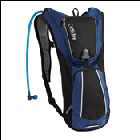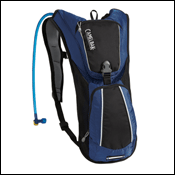I think you’re after two different things here, John. Maybe three. For a triathlon, I wouldn’t think you’d want anything more than a lightweight, compact hydration pack—something such as ’s Rogue Hydration Pack ($58). It’s just big enough to hold two liters of fluid, plus a few energy gels or arm warmers. And its streamlined shape is ideal for cycling. But really, unless you’re doing something more than Olympic distance (40-kilometer ride), I’d get by with bottles. I just don’t think a pack is necessary.
The Rogue
 The Rogue
The RogueBesides, for snowboarding or camping you’d need a much bigger back than would be remotely useful on a bicycle. For that, you’d need something such as the Blade pack ($135). It’s purpose-built for snow sports, and can carry a snowboard or a pair of skis. Plus it holds tools such as shovels, poles, and extra food or clothing. It has 1,800 cubic inches of capacity, which qualifies as a mid-sized daypack. Too big to put on your back and take biking—it weighs four pounds, for one thing. Plus it’s fairly bulky and non-aero. ’s Quiver pack ($65) is a little smaller (1,500 cubic inches), holds skis or snowboards, and has a little more “urban” look than the Dakine.
By “camping,” do you mean “backpacking?” If so, then that is a third kind of pack. Here’s you’re looking at something such as the Aether 85 ($289), a full-featured backpack that can handle loads for close to a week of hiking. Or, for a good day-hiking pack, go for something such as the Lookout 40 ($90), a comfortable, nicely detailed daypack with lots of pockets for organizing stuff and enough capacity (2,440 cubic inches) to take a full day’s worth of gear.


